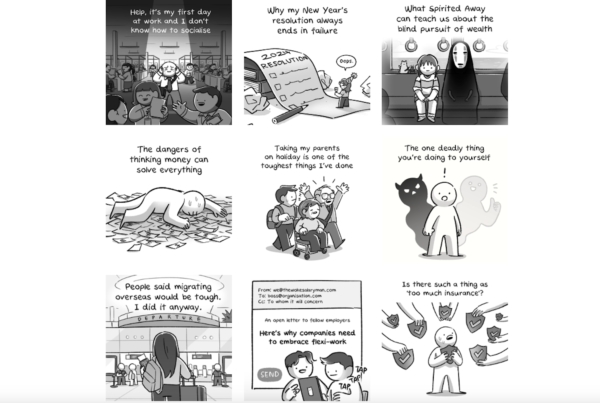The concept of content marketing is not new.
In fact, one of the earliest examples of content marketing goes as far back as 1732.
That year, Benjamin Franklin (yes, the inventor) published the first annual issue of a magazine he dubbed as the Poor Richard’s Almanack, with the goal of promoting his printing business.
It ended up selling pretty well for the next 25 years, printing up to 10,000 copies per year.
In fact, it became a bestseller in the American colonies, so much so that Napoleon (yes, the conqueror) ordered it to be translated into Italian and French.
He didn’t know it then—the term ‘content marketing’ was only coined much later in 1996—but Franklin was practicing the very definition of it:
Providing useful or entertaining content (such as weather predictions, sayings, and poems) that communicated the value of his product/service (printing) without actually selling anything.
Or, in his own words: “I considered it as a proper vehicle for conveying instruction among the common people, who bought scarcely any other books.”
Fast forward to present day, and much of what people consider to be content marketing today is as far from this example as you can imagine.
Especially when it comes to the “selling” bit.
We’ve gotten content marketing all wrong
To be sure, the term leaves a lot of room for interpretation.
For instance, aren’t images, videos, and words all content of some sort? If so, shouldn’t all marketing be considered as ‘content marketing’?
That depends on how the content is being used. And that’s where many people get it wrong.
On that note, it’s question time!
Imagine that you’re a marketer for a mattress company. Which of the following options would you consider to be ‘content marketing’?
Ready?
Option 3 is the right answer! It is, in fact, an article written by an actual mattress company called Casper, which is worth $750 million today.

Option 1 is an instance of branded content—less sneakily known as native advertising.
Here’s a real-life example (not related to mattresses) titled, 5 Adventures In Khao Yai To Explore Thailand’s “Outback” On A 3D2N Trip, from TheSmartLocal:

Option 2 is a classic example of a media mention—the result of a good public relations strategy in action.
My point? Content marketing is not advertising or public relations.
And the one reason why content marketing isn’t working for you is because you’re treating it as advertising or public relations.
Content marketing is not advertising
In the West, marketers and founders are starting to get it, and we’ve seen the fruits of their resulting labor in recent years, as well-read, well-loved company blogs and resource hubs have emerged from the fray.
Think Buffer’s social media marketing blog, Help Scout’s customer loyalty blog, or Oberlo’s dropshipping blog.

Over on our side of the world, however, we’re slightly slower on the uptake.
“I don’t get it, Daniel. Why would you want to spend time and effort publishing content that does not mention your product or service, or promote it in any way?” is the million-dollar question that potential clients always ask me.
They point me to blog posts written by local companies, which typically have a heavy sprinkling of product or brand mentions.
Then I find out from their frustrated marketers and founders that no one is reading their blog posts.
Their conclusion? Content marketing just doesn’t work in Singapore, or anywhere in Asia.
But that’s because what they’re publishing are advertisements.
Here’s an example I recently came across from a company based in Singapore (company name redacted):

Other than stating the obvious (well, yeah, of course massages “soothe depression and anxiety”), the writer also conveniently threw in links to the company’s vendors in four out of the five points made.

If this isn’t an advertisement, I don’t know what is.
A word about advertising
To be clear, that’s absolutely nothing wrong with advertising.
Companies with deep pockets, that are looking for a quick way to get ‘eyeballs’, have used ads as part of their digital marketing repertoire to do exactly that.
A study conducted by Hubspot across Asia Pacific found that almost all of their respondents had come across advertisements of some sort:

Not surprising, given that Asia Pacific might well become the biggest contributor to global ad spend growth—putting us ahead of our Western counterparts—accounting for 33.8 percent of global ad spend in 2020.
Mission accomplished, right?
But what do consumers actually feel about them?
Well, they’re not exactly welcoming ads with open arms:

In fact, the majority of consumers in Asia Pacific either detest ads, or have no opinion about them whatsoever—neither of which are indicative of great marketing.
Also: ad blockers. To date, popular ad blocker Adblock Plus (which is free to use) has accumulated over 500 million downloads.
More bad news for marketers across the globe.
No wonder marketers across Asia Pacific aren’t very concerned about trying to figure out the next move for ads—the consumer has spoken.
Instead, according to a report published by NewBase, the number one priority of APAC marketers seems to be content marketing:

Yes, there are ads that are entertaining, educational, and actually worth watching and reading till the end.
Those Thai ads—so good.
But that doesn’t conceal the fact that the intention of ads are solely to sell a product or service. For this reason, even native advertising doesn’t get a pass.
The trust of someone who clicks on an article hoping to learn something from it, but finds an ad instead, will instantly disintegrate.
Good content marketing: no selling, only educating
Thankfully, there are a handful of companies in Asia who are doing content marketing right—and reaping the rewards.
They practice the rightful definition of content marketing:
Providing useful or entertaining content that communicate the value of their products/services without actually selling anything.
Pay special attention to the italicised words. That’s where the moneymaker is.
I will be doing case studies on these companies in future blog posts to find out why and how they did it.
Case study: 99.co’s property news and stories blog
For now, let’s do a mini case study featuring a property portal based in Singapore called 99.co.
The team writes regularly about property-related news and stories on their blog, and has been doing so since late 2013.
Not too long ago, I joined the demographic of readers who might be interested in the content published by 99.co—those looking for an apartment to purchase or rent—and was struck by how useful the articles were.
In particular, an article titled, What HDB didn’t tell you about Punggol (and Pasir Gudang), caught my eye as I had put down a deposit on a HDB flat in Punggol.

This blog post checked out all the right content marketing boxes. It was:
- Useful, as it made me think twice about my decision to buy an apartment in Punggol
- Entertaining, because it was filled with interesting facts and figures regarding the issue with living in Punggol—I learned something new, and had something fresh to share with my friends
- Valuable, as I would not have known about this issue anywhere else—the journalistic equivalent of a newsworthy piece
And yes, not a single mention of 99.co’s products or services within the article (apart from the standard call-to-action that appears at the end of all their blog posts).
Sure, their blog posts are not perfect.
Some of the paragraphs are lengthy and hard to scan through, the font size used is a tad small for reading comfortably, and I had to Google some of the terminology used one too many times.
Top-notch content writing is not easy—something I learned through years of hard work—but that’s a story for another day.
And there are plenty of other things to consider in a content marketing strategy, like SEO, distribution, and so on.
But unlike many other companies, they’ve managed to nail the most fundamental content marketing principle—no selling, only educating—which in my book makes them one of the best content marketing examples in Asia.
Over to you
Yes, content marketing isn’t easy.
Nor should it be. Because, when done right, it can produce incredible, far-reaching results for your company.
As venture capitalist Tomasz Tunguz puts it:
“Content is one of the few forms of marketing that has a compounding return […] Like a bank account that starts out small and earns incremental gains, but over time becomes quite large, content marketing efforts require consistent investment but ultimately can yield enormous results.”
And this boils down to whether you’re able to consistently squirrel away valuable content into your content marketing bank account.
—
200+ industry-leading tech companies in Southeast Asia are happy clients of With Content. Join them and start delivering valuable content to your potential customers today.



